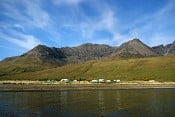
Interesting article about a guy called Doug Larsen who has found very old trees (1000+ years) growing on crags in Canada, France and England (doesn't mention where in England).
https://www.theguardian.com/environment/2023/dec/14/doug-larson-i-discovere...
Take care of them trees folks (including when abbing off). I think there's going to be progressively more interest in preserving crag biodiversity.
> I think there's going to be progressively more interest in preserving crag biodiversity.
We can only hope so, the desire for indoor wall ‘clean’ crags is becoming somewhat problematic I believe. Pulling out every last bit of vegetation on low grade routes where it makes not a jot of difference, in the name of tidiness.
>the desire for indoor wall ‘clean’ crags is becoming somewhat problematic I believe. Pulling out every last bit of vegetation on low grade routes where it makes not a jot of difference, in the name of tidiness.
A ridiculous statement. Too many appalling crag cleans to manufacture climbs from heavily vegetated rock predate any indoor walls. These days we have restrictions and advice on crag cleaning or winter use, especially as it relates to rare plants or fauna disturbance. We have entire crags where climbing is banned in some cases. Removing small sections of common flora like trimming off birch saplings, sprigs of common heather or a few common bracken bulbs on holds, where it is abundant on most of the nearby rock, hurts no one.
Predate, and continue to this day. Removing common species might not seem damaging on the face of it but you’re also removing the root structure which can host invertebrate life and in turn feed the birds and small mammals. Such common species also provide cover for cliff dwelling creatures. You’re correct in that removing it from small sections may not cause much harm but to claim it’s abundant on most of the nearby rock is a bit of a debatable statement. Added to the fact that climbing is far more popular today than it was pre-indoor wall the additional traffic crags deal with also stops them being allowed to recover ecologically.
Hang on, normally on here people are blaming wall-bred climbers for classic mountain trad crags going back to nature. Now we're blaming them for keeping crags too clean as well?!
am sure its a good thing we become aware of crag biodiversity - some rare and fragile ecology on some of them (probably not on climbed ones).
I always wondered how old the yew trees were on North Crag, Castle Rock. The one at the top of Overhanging Bastion had lots of character I felt, the one on North Crag Eliminate also - but pretty shot at (and was then in Kong wall for some time after the crag fell down!)
Personally I’m blaming the outdoor climbers who want to recreate the sanitised, reliable conditions of the indoor wall, outdoor.
How about some examples, given we are both moorland grit devotees? Most lower grade climbs, in particular more than 50% on the Peak and Yorkshire grit that I know best (the best documented area anywhere that I know), are being heavily degraded and many are effectively lost. I'd guess many no star climbs on the more obscure moorland crags have less than an ascent a year. Heather and bracken and their root structures and cover are everywhere on the moors. On crags where birch saplings are a real issue, birch is common.
Any crag cleaning I've been involved with just keeps worthwhile routes climbable (nothing like the same as denuding them). It’s ecologically unsound and incredibly hard work (with imponderable motives) to remove all vegetation from obscure crags, let alone areas with no routes. As a guidebook worker I've been part of recommending poor climbs should be allowed to return to nature (including a buttress at Stanage... which now has) and minimising information on obscure overgrown areas.
> Removing small sections of common flora like trimming off birch saplings, sprigs of common heather or a few common bracken bulbs on holds, where it is abundant on most of the nearby rock, hurts no one.
Surely you're aware that pulling out heather from a grit outcrop anywhere within a Pennine SSSI moorland without talking to Natural England first is a bad idea?
Where did I say "pulling out" heather from an SSSI?
> Personally I’m blaming the outdoor climbers who want to recreate the sanitised, reliable conditions of the indoor wall, outdoor.
As opposed to previous generations who cleaned the heck out of stuff to recreate .....?
In the bit of your post that I quoted in my reply to you
Good question, when did heavy handed ecocide first begin to be routinely accepted amongst the climbing community as a means to expand horizons? Was Puttrell known for his heather removal talent?
I said "...trimming off birch saplings, sprigs of common heather..." I've been trimming heather with clippers (away from SSSIs) for decades and I know the heather thrives afterwards.
I'm pretty sure Puttrell's grit routes would have been clean enough and ready for plucking given pollution levels at the time. There were a hundred routes in 1900 at Wharncliffe (more routes at those grades than in the 1989 definitive), including many of his. Some of his routes in the woods at Wharncliffe are now overgrown, only a few on the edge are identified as his.
> Good question, when did heavy handed ecocide first begin to be routinely accepted amongst the climbing community as a means to expand horizons? Was Puttrell known for his heather removal talent?
Every single "natural" area climbers enjoy is a victim of heavy handed ecocide.
https://www.ukclimbing.com/photos/dbpage.php?id=291420
A photo clearly demonstrating how cleaner air has meant that many crags are more vegetated than they were 50 years ago
I know of one tree, and a tree expert mate of mine surveyed it a few years back (for tree register.org), that's halfway up a popular crag and thought to be near 1000 years old. You'd realise it was an old tree but the average climber wouldn't realise just how old it is. Unfortunately I can't identify it here, but I'm sure quite a few people would have seen it.
If anyone here is irritated by me mentioning something then not identifying it, I know a tree that when that was thought to be the UK'S tallest known tree, had someone climb it with spurs/spikes to make a YouTube/GoonTube video and they ripped the **** out of the bark. If I identify this crag one publicly it'll get a heap of people ab down to it and clambering all over it snapping branches for GoonTube. So that's why they get kept off-radar (sorry).
how do they survey for age, out of interest? do they drill a sample for rings or just estimate from diameter or something?
> Hang on, normally on here people are blaming wall-bred climbers for classic mountain trad crags going back to nature. Now we're blaming them for keeping crags too clean as well?!
Which is why I hope you'll join my campaign to 're-wild our walls'.
Each time I visit the wall I am surreptitiously putting a mix of seeds from wild flowers, mosses, bramble and native woodland species in my chalk bag and liberally applying them to holds. I anticipate that with favourable conditions we can ensure the wall replicates the charm of an abandoned quarry in just a few decades.
How many climbers can correctly identify the plants that they remove in order to confirm that they are common?
Do you surreptiously loosen the holds as well, to give that true Llanymenach or Scout Scar effect?
I would imagine that sample rings would give the most accurate estimate of age. Girth can vary according to conditions of growth so mountain trees tend to be smaller than the same species growing in a fertile valley
I wouldn't mention the location of such a tree here either.
Some climbers take great care to find out before they clean, some stick to what they do know, some are well intentioned but ignorantly damaging, a few are clearly vandals who don't give a shit. All I can say is the BMC and the access teams I've worked with take the matter seriously and in the years I've climbed attitudes have changed very much for the better.
> Do you surreptiously loosen the holds as well, to give that true Llanymenach or Scout Scar effect?
People are always bemoaning the lack of 'real world' skills that wall bred climbers are missing out on. I think your suggestion is useful but is just a start.
I would like to see walls that require a 3hr walk in, a sea level traverse or a committing abseil approach.
Routes descriptions should be vague, tenuous or just plain fanciful.
Topos must be banned and climbers should only really know their location on the wall after a minimum of 10 visits.
In spring and early summer a random smattering of choice looking lines will be covered in guano and a drone will attack climbers to mimic the quiet thrill of sea cliff climbing.
Lighting will be on a random timer so that climbers can experience the joys of benightment.
All walls will be required to demonstrate significant levels of seepage around crucial holds unless the ambient temperature is above 30 degrees Celsius for 14 consecutive days.
Dog shit and/or a dead animal carcass your choice will be put at base of all routes graded with a least one star.
> Some climbers take great care to find out before they clean, some stick to what they do know, some are well intentioned but ignorantly damaging, a few are clearly vandals who don't give a shit. All I can say is the BMC and the access teams I've worked with take the matter seriously and in the years I've climbed attitudes have changed very much for the better.
Steady on now, you are dangerously close on suggesting that climbers are nothing special and just the same as the rest of the population
I'm told that it's serious (not a joke) to say that the only really accurate way is to cut the trunk and count the rings, so it's an estimate based on girth location and other indicators, but I'm also told sometimes a sample can be taken for dating (carbon? not sure) if it's cracked through already and doing so wouldn't be harmful. Dunno much more than regurgitating this dumbed down explanation I got, hope I haven't altered and corrupted it too much in the retelling
I would think there are literally Km2 of vegetated cliffs throughout the UK and most are totally unsuitable for climbing so in the greater scheme of things UK cleaning damage is minimal to flora and fauna. To me far greater damage is done by climbers jetting all round the world at the drop of a hat and several times a year. Wrecking delicate eco systems and shoehorning an imbalance and damage into local culture I laugh out loud at people travelling to the Alps by bus to go skiing and minimise a carbon footprint. It’s virtue signalling and greenwashing and as everybody knows carbon offsetting is a con. It’s impossible to think of a more damaging pursuit than a ski resort, on all levels. Kalymnos would be a climbing microcosm of this with literally thousands of climbers from all continents congregating on a small rock in the Aegean Sea, the vast majority by air. When I started climbing Easter at Tremadog seemed exotic, usually hitching to get there, but not now.
I don't disagree with most of that, but that doesn't mean that cleaning routes is always ok.
This is also true of Caley or Woodhouse Scar. In recent years there's more vegetation at crags than there ever has been. Whole bouldering areas are shrinking.
I co-wrote Woodhouse Scar for the current YMC definitive and until the pandemic helped those trying to balance flora and climbability... the main problem there being brambles and rubbish. The increasing greeness of some of the boulder problems fortunately didn't seem to affect the climbing much, given the rough rock. The routes in contrast were polished more than half a century back according to old locals.
Woodhouse Scar already has lie down starts under low roofs








